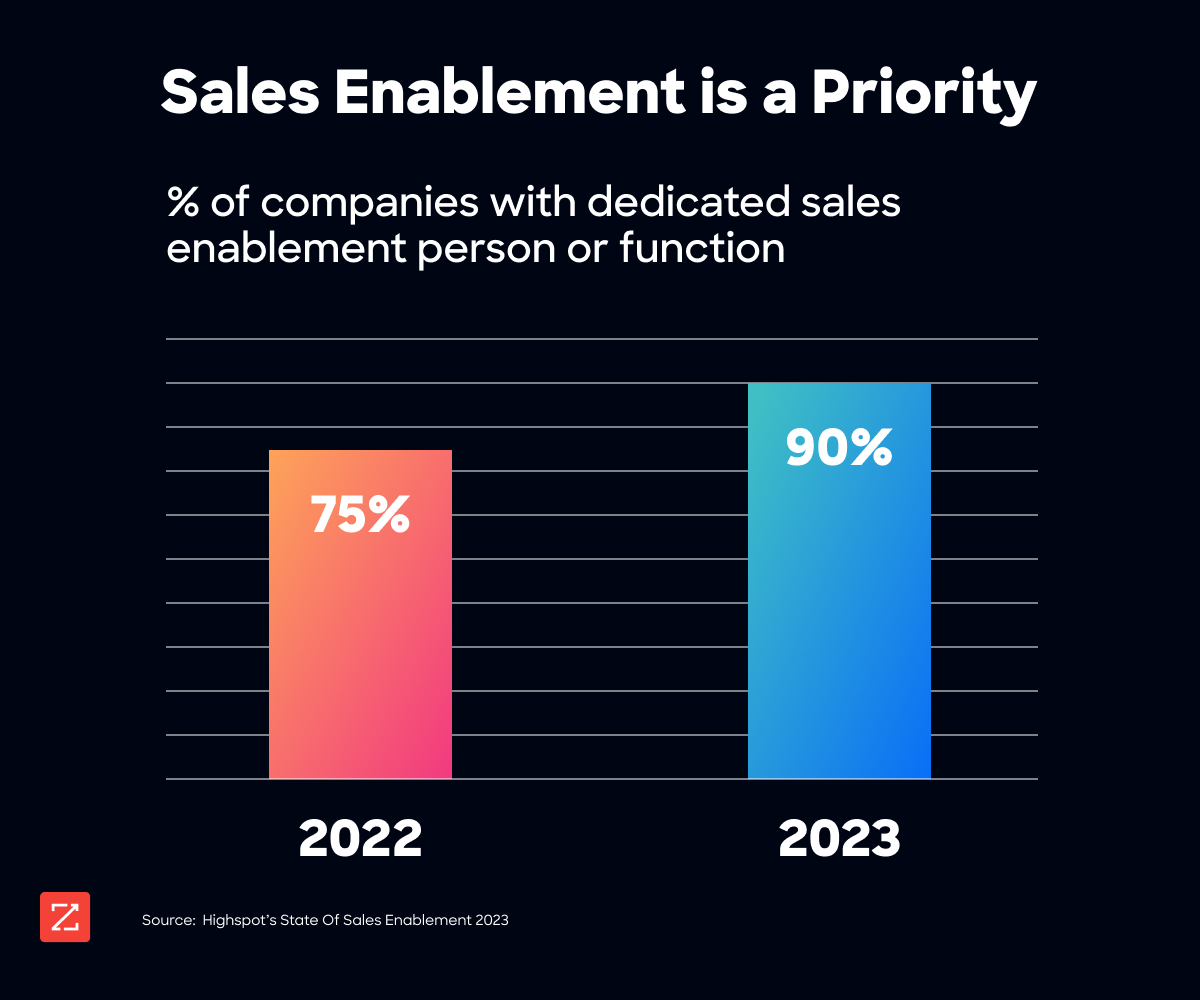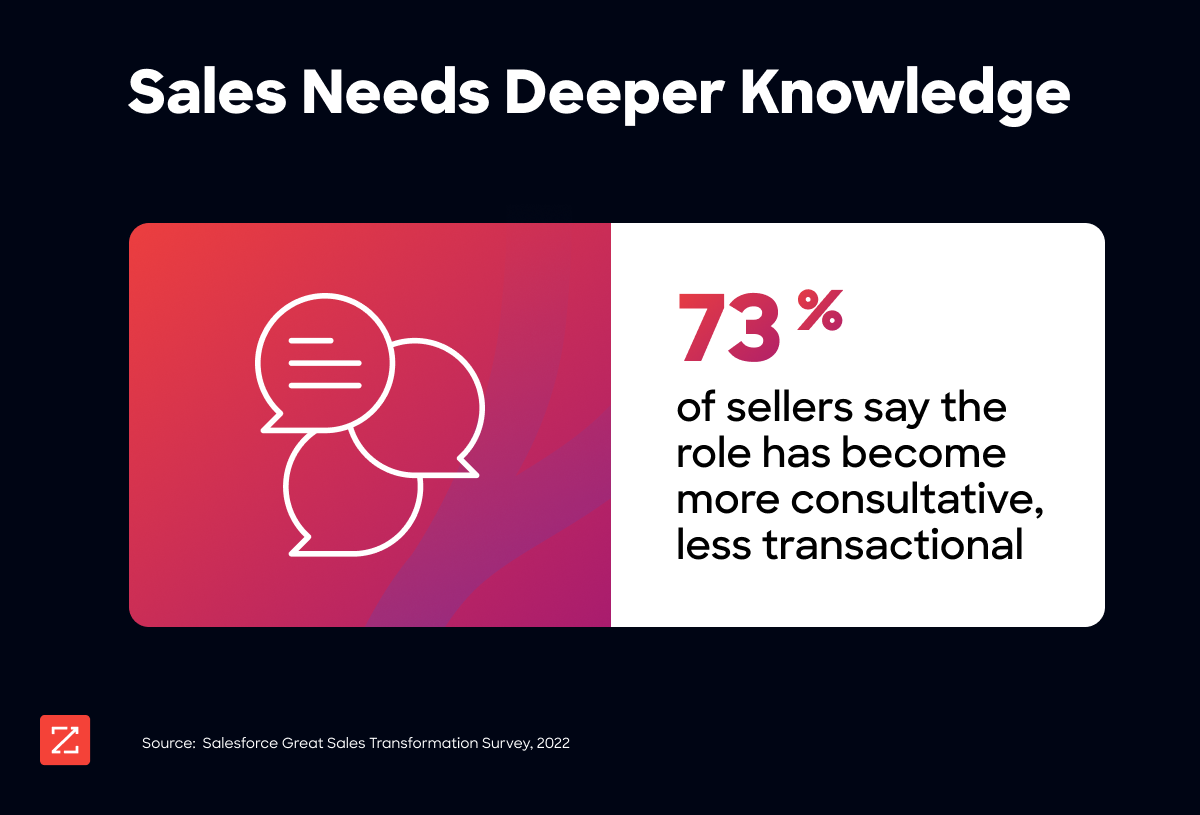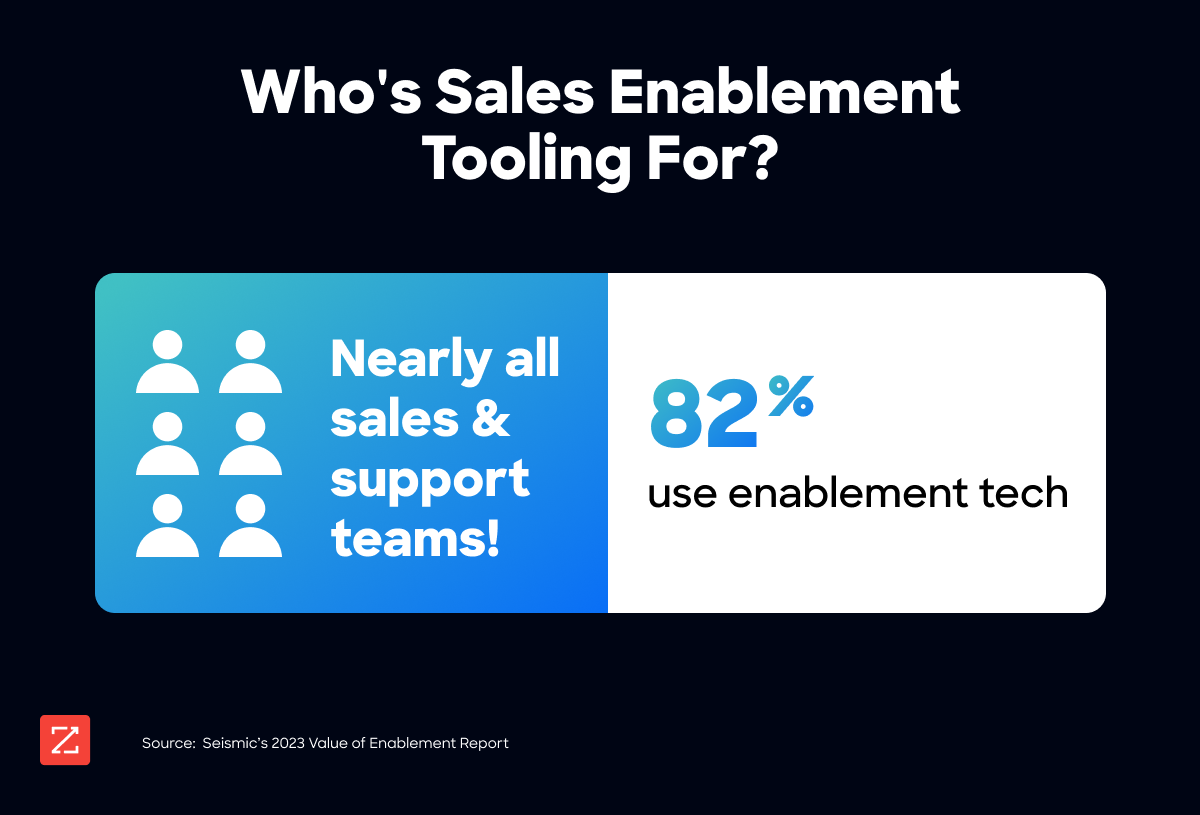To be successful, sales professionals need to be experts in many different areas at once: their product’s strengths and weaknesses, their prospects’ pain points and needs, and the broader economic and competitive landscapes.
You can throw in tactical skills like effective messaging, multi-threading, persuasive cold-calling, and much more.
To give sellers a fighting chance, sales leaders need to build an effective, flexible sales enablement program. With the right sales enablement process, revenue leaders can confidently improve sales team skills, boost customer retention, expand market differentiation, and drive revenue growth.
But what does it actually look like to implement a sales enablement program? Success relies on a comprehensive understanding of the definition of sales enablement, why it matters, who should be involved, and how sales leaders bring it to life.
What is Sales Enablement?
Sales enablement is the process of providing content, guidance, and training for sales teams to effectively onboard, interact with buyers, shorten the sales cycle, and ultimately win more deals.
Although “sales enablement” remains the most prevalent term, you may also see similar technology and processes referred to as “revenue enablement” and “go-to-market (GTM) enablement.” That reflects the fact that effective enablement relies on contributions from multiple teams, including product, marketing, and customer success.
While we’ll stick with “sales enablement” for the most part, know that we always mean it to include the full breadth of revenue professionals.
The Difference Between Sales Enablement and Sales Operations
Sales operations as a department covers every component of driving sales, for example, setting quotas, defining territories, and determining compensation.
Meanwhile, sales enablement focuses on the sales team that sales ops has helped build. Its goal is to boost sales effectiveness — while hitting the goals sales ops has set.
These two disciplines intersect and should inform each other, but the focus and goal of each is different.
Common Sales Enablement Activities
What makes up the content, guidance, and training that’s so pivotal to providing sales and revenue specialists with the resources they need to engage customers and create conversions?
Here are some of the most important tasks:
Onboarding sales teams
Ongoing learning initiatives for sales
Developing assets to reference and use (case studies, email templates, etc.)
Creation and implementation of sales training and coaching programs
Interdepartmental communication
Managing sales lifecycles and best practices
Reporting and iterating on sales enablement programs
Collaborating on sales events such as kickoffs
Related reading: Better Sales Coaching: 7 Effective Sales Coaching Techniques
Who’s Involved in Sales Enablement?
Successful sales enablement necessitates a collaborative effort between marketing and sales, and oftentimes other teams as well. A dedicated sales enablement leader or manager typically oversees this collaboration and delegates the day-to-day components of sales enablement. In the absence of a designated manager, the responsibility often passes to a sales executive, such as a vice president of sales.
Sales operations leaders play an important role in translating the enablement vision of the sales VP into reality. Leads from other teams involved in sales enablement — such as product and customer support — may also be fashioned into a dedicated team to determine the best sales processes and technology to move enablement forward across disciplines.

Why Sales Enablement Matters: the Benefits
Effective sales enablement drives value across the revenue operation, and can be the difference between sales teams that reach scale and those that never quite fulfill their potential. Enablement also has a halo effect on your culture and talent retention, giving sellers the tools, tactics, and confidence to stay motivated about building their careers.
Here are five specific ways sales enablement can contribute to broader company success.
Scale Team Skills for More Wins
Great sales enablement means lower- and middle-tier performers can maximize their capabilities. This reduces your dependence on high-performing sellers, who too often shoulder the brunt of the workload, making them prone to burnout.
Beyond the sales function, sales enablement offers advantages to every department involved in customer interactions. Sales engineering, customer success, and support teams all require content and training. Why not make sure they’re all aligned under a complete sales enablement strategy?
Drive Sales and Marketing Alignment
As the last touch in a go-to-market strategy before retention efforts kick in, it’s imperative that sales understands and is ready to translate brand, product, and service value in every conversation with potential customers. Who can help them deeply understand and also find a variety of ways to communicate this value?
Marketing.
Marketing departments create brand language that resonates with buyer personas. Sales should use this same messaging throughout the sales cycle. Instead of the two departments operating in silos, sales enablement facilitates sales and marketing alignment to optimize playbooks, success stories, statistic sheets, emails, sales scripts, and other conversion-focused resources. The result is cohesive messaging throughout the entirety of the customer journey that consistently emphasizes value and ROI.
Boost Sales Velocity
With improved access to superior data, tools, and other resources through sales enablement programs, sales reps are better prepared to have more productive customer conversations and streamline the buyer journey, enhancing sales velocity.
This is particularly important in tighter economic conditions and in B2B contexts, where sellers are seeing longer sales cycles and larger buying committees almost as a rule — every bit of velocity matters.
Prepare Sales to be True Experts
Nearly three-quarters of sales professionals surveyed told Salesforce that their role today feels more like consulting.
Today’s sellers need to have expertise and experience with what they’re selling, as well as whom they’re selling to, to close the deal. Sales enablement gives them the chance to learn and interact with their product offerings on a regular basis. This increased involvement enhances the value they bring to each sales conversation and better equips them to answer prospects’ questions.

Differentiate Your Sales Approach in a Virtual Future
Salesforce found that more than half (58%) of sales professionals are having a hard time with virtual selling — and well under half (29%) are get training on how to do it.
Sales enablement can equip sellers with the new skills they need to be effective from behind a screen. This will set your business apart in sales success, as well as employee morale and customer retention.
5 Steps to Building a Sales Enablement Strategy
Ready to do the work? Let’s walk through five practical steps for implementing a basic sales enablement strategy — or enhancing if you’ve already started.
1. Establish Strategy Goals
It’s important to nail down exactly what you want to achieve with sales enablement, and which metrics will indicate success. With these elements in place, sales leaders and individual contributors can work toward, measure, and improve your sales enablement program.
Here are a few common sales enablement goals, as well as an example of a metric you could use to measure the success of each:
Goal: Increase sales productivity
Metric: Sales cycle length
Sales cycle length reflects the time it takes for a sales rep to transform a cold lead into a successful deal.
Goal: Improve sales efficiency
Metric: Win rate
Win rate represents the percentage of successfully closed deals in your sales pipeline. A competitive win rate indicates sales is proficient in closing deals.
Goal: Increase revenue
Metric: Deal size
Skills for closing larger deals can sometimes be overlooked in sales training. Grow revenue and average deal size by teaching sellers how to move higher-priced products, add-ons, upsells, and bundles.
2. Choose Leaders Carefully
The makeup of your team should be based on your sales enablement process and revenue goals.
For example, if increasing sales productivity is a major objective for your team and you’re hiring for a head of enablement, look for someone with experience in training toward shortening the sales cycle.
If you’re looking to fill this role from within, tap someone, or a small group, who can help with the training and tools you’ll need to get more productivity out of current systems.
3. Define the Sales Behaviors You Expect
After establishing goals and selecting who’s going to help meet them, it’s time to consider which sales rep behaviors will move you toward goal achievement.
Continuing with the example goal of increasing sales productivity by shortening the sales cycle, you might need to shift focus toward people with more decision-making power. You might then want sellers to increase their product knowledge and pricing leverage, so they can close deals with less back-and-forth.
How does seller behavior change happen? With lots of planning and support.
4. Provide Training and Support for Desirable Behavior
To meet ambitious sales goals, you will need to build out your training systems, readily available resources, and support technology that will help sales teams change their behavior.
Part 1: Sales Enablement Training
In the productivity scenario we’ve been using, you could design content that teaches your sales team how to research companies to find decision-makers. You could then add courses that improve their skills in talking to people in a way that gets right to their problems and your value proposition. Training can also build their acumen and confidence in cutting small discounts and other deals to win accounts.
Additionally, leadership should make themselves available for one-on-one coaching sessions and offer personalized guidance if reps need help.
Part 2: Sales Enablement Tools
More than 80% of GTM leaders say they’re using sales enablement technology on their teams, and virtually all agree that it makes their jobs easier.
Saying that you should be adopting tech as part of your enablement strategy is an understatement. The tools you choose should be guided by factors such as your business firmographics, your operational structure, your sales team’s typical approach, and your audience’s buying journey.
There is no foolproof formula that will work for every sales enablement tech stack. There are, however, common themes across the most successful sales enablement teams.
Modern sales enablement platforms can help you manage sales enablement collateral and training lifecycles. Sales enablement software typically combines features such as content management and sharing, sales training and onboarding, and end-to-end analysis.

5. Measure and Iterate
There are a lot of metrics you can track to understand the progress and success of your sales enablement program.
First, there are the metrics associated with your big goals. In this article we’ve used the example of increasing sales productivity. To know if you’ve achieved that, you can track the sales cycle length and see if it’s shorter or become more simplified each quarter. You can also track team-based metrics, such as hours of training completed, number of coaching sessions done, and how many sales enablement resources have been created and consumed.
There are also several sales performance indicators that are often associated with sales enablement success, including:
Time for sales to complete onboarding
Prospect-to-customer conversion rate
Content usage by prospects
Total time spent selling
Sales enablement leaders should review their sales KPIs at least once a quarter to assess the effectiveness of the enablement strategy, check on progress against key milestones, identify what is working and what isn’t, and — most importantly — make adjustments to ensure targets are met, morale is high, and enablement continues to boost revenue and competitiveness.
Sales Success is Out There
A successful sales enablement strategy can lead to success in sales, as well as across your revenue-generating teams. But even the best strategy can’t maintain momentum without a dynamic team, an integrated tech stack, and high-quality business data and buying signals.
Sign up for a free trial to see how our exceptional data and intelligent GTM tools can help your enablement team fuel sustainable sales success.


